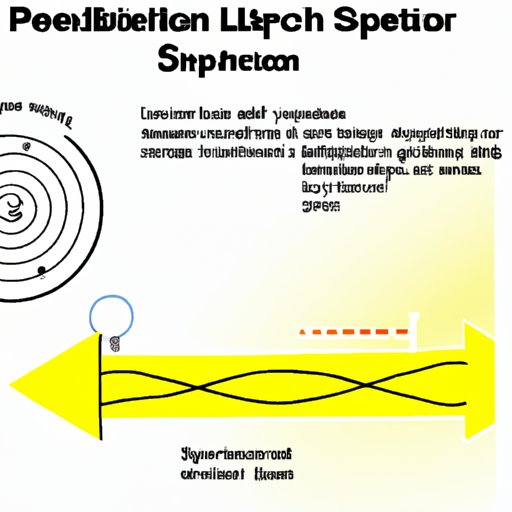Introduction
Understanding the speed of light is crucial in many fields of science and technology. The speed of light in one second is truly remarkable, and it’s important that we comprehend its vastness. In this article, we will delve into the world of light and its velocity, discussing various aspects such as its measurement, comparison, velocity, distance, and perception.
The Speed That Will Blow Your Mind: Understanding How Fast Light Travels in One Second
Before understanding the speed of light in one second, we must first understand light in general and its characteristics. Light is a form of electromagnetic radiation that can be seen by the human eye. With a speed of 299,792,458 meters per second, light is one of the fastest phenomena in the universe. This speed is known as the speed of light and is measured in a vacuum.
The speed of light is measured using various methods such as the Foucault Method and the Michelson-Morley Method. The methods utilize the principles of optics, assuming that the speed of light is constant.
If you’re trying to gain perspective on how fast light travels, here’s one: the speed of light is approximately 186,282 miles (299,792 kilometers) per second.
A Second in the Life of Light: Exploring the Speed of Light Travel
To understand the speed of light in one second, we must comprehend the concept of time perception. Time perception is the ability to observe and estimate the duration of an event. A second is the duration of 9,192,631,770 oscillations of a cesium atom’s outermost electron, making it a reliable measure for some of the most fundamental physical processes.
With this knowledge, we can measure how far light can travel in a second. In one second, light can travel 299,792.458 kilometers or 186,282.397 miles. It may seem like a tiny distance, but it is massive when we consider the vastness of space and our solar system.
One way to visualize this distance is to imagine the circumference of the Earth, which is approximately 40,075 kilometers (24,901 miles). Light can travel around the Earth about 7.5 times in one second.
Light the Torch Bearer: How Far Can It Travel in One Second?
Light doesn’t just travel through a vacuum; it can also move through different mediums like air, water, and glass. The speed of light can vary depending on the medium it travels through, but it is still incredibly fast.
For instance, in water, light travels at a speed of approximately 225,000 km/s or roughly 139,808 miles per second. In glass, the speed of light is even slower, with the average speed estimated to be around 200,000 km/s (124,274 miles per second).
Despite the variance, it’s essential to note that light always travels at the same speed regardless of the direction it’s moving.
One Second, One Light Year: A Quick Guide to Light Speed
A light-year is the distance that light can travel in one year with a constant speed of 299,792,458 meters per second. One light-year is equivalent to approximately 9.461 trillion kilometers or 5.878 trillion miles.
Light-year is used to measure astronomical distances since it’s easier for scientists to express huge distances in these units. For example, the nearest star to our solar system, Proxima Centauri, is roughly 4.24 light-years away.
The vastness and complexity of space aren’t easy to comprehend, but we can use light years as a primary unit of measurement in astronomy.
Beyond the Blink of an Eye: Measuring the Distance Light Travels in One Second
Scientists use numerous methods to measure the speed of light accurately. One of the methods is the use of lasers, which send out a beam of light to a mirror and then back to the source. By recording the time frames of the beam’s travel, they can calculate the speed of light with pinpoint accuracy.
Accurate measurements of light’s speed have contributed significantly to the development of many technologies and scientific research. Without accurate knowledge of light speed, we couldn’t have developed GPS technology or advanced telescopes.
The Need for Speed: An Overview of Light’s Velocity in a Single Second
The speed of light in one second is an essential concept that we should all comprehend. It’s critical to various fields of science and technology, including astronomy, chemistry, and physics. By understanding the speed of light, we can explain seemingly complex phenomena like black holes and the Big Bang Theory. We also rely on the principles of the speed of light to design and develop advanced technologies like GPS and laser applications.
The more we learn about light’s velocity, the more we can comprehend the beauty and complexity of nature’s wonders.
Conclusion
The speed of light in one second is an incredible phenomenon that deserves our utmost attention. We’ve discussed how light’s velocity is measured, how far it can travel in a second, its characteristics, and its various applications. Understanding the speed of light is fundamental to our knowledge of the Universe, and it has played a significant role in our technological advancements. As we continue to explore different fields of science, from astrophysics to quantum mechanics, light’s velocity remains a critical concept. Let’s take a moment to reflect on the beauty of the cosmos and the extraordinary phenomena that make up our reality.
(Note: Is this article not meeting your expectations? Do you have knowledge or insights to share? Unlock new opportunities and expand your reach by joining our authors team. Click Registration to join us and share your expertise with our readers.)
